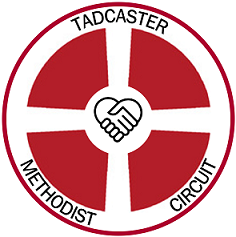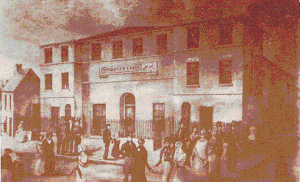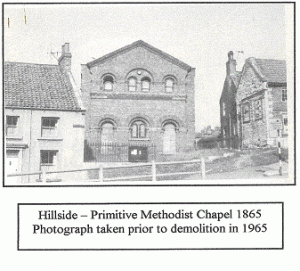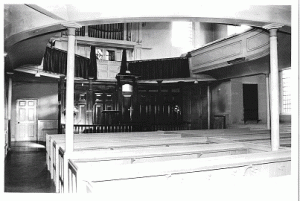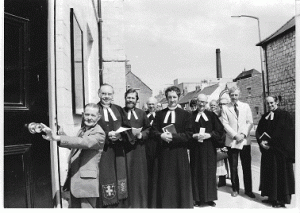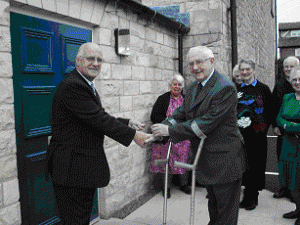Our History
PART 1: ORIGINS AND DEVELOPMENT 1759-1828
We know from John Wesley’s diaries that he preached in Tadcaster on at least eleven occasions between 20th April 1759 and 4th May 1786 and he may even have made an earlier visit to Tadcaster in the middle of July 1757 during a few days in York. An entry in his diary dated 3rd July 1776 reads, “A glorious work is dawning here against which nothing can prevail.”
This small market town of Tadcaster, for centuries noted as a meeting place with good inns and ales, was no stranger to Dissent, several non-conforming religious groups having been active before Wesley’s birth. Some one hundred years before Wesley first visited the town the government was experiencing severe opposition to attempts to restrict organised worship to the Church of England so Charles II issued a Declaration of Indulgence, which allowed the licensing of religious meeting houses. The first of these in Tadcaster was for Dissenters’ meetings in the house known as Morley Hall and now as The Ark.
It was in this climate that Methodism was born in Tadcaster. Other non-conformist groups in the town did not appear to flourish as well as Wesley’s followers. The Vicar, Mr Noble, reported in 1764 that the town had about “340 families, 23 Dissenters (15 Methodists, 6 Papists, 2 Quakers) and 2 licensed Meeting Houses.”
John Wesley himself commented “Wednesday, 23rd July 1766. I went on to Tadcaster. Here, Mr Ingham had once a far larger society than ours, but it is now shrunk into nothing. Ours, meantime, is continually increasing.”
Gradually Methodism was becoming well established with new groups constantly forming in the town and surrounding villages. Wesley travelled thousands of miles each year, visiting his societies and preaching in public; in fact he partly attributed his strength and longevity to this. He managed to preach in Tadcaster about once in every two years, the last known occasion being Thursday 4th May 1786, when he was eighty-three years old!
When John Wesley established “the Conference of the people called Methodists,” his own definition of his followers, what had once been used as a derisory term against them was now a welcomed distinguishing feature, although it was still some years before the final separation from the Church of England.
Over the next few decades the circuits were formalised and the organisation became much more efficient. Finances improved, the building of chapels began.
The increase in numbers and recognition of Methodism as a separate sect eventually obliged the Tadcaster faithful to apply for a Dissenters Meeting House Licence in 1796.
The initiative for a chapel was led by Jonathan Robinson, described as ‘gentleman’ to indicate his wealth and social standing in the community. In June 1773 he bought from the tailor William Bradley a part of his garden in the Near Back Lane of Tadcaster (now Chapel Street) for £24. The plot contained 132 square yards, being the eastern part of Bradley’s garden.
Robinson gave this land to a group of Trustees with the proviso that they
should cause to be erected and built on the said piece of ground A house in length from and towards the south to north about twelve yards and in breadth from or towards the east to west about ten yards and as soon as the said building should be completed they and the survivors of them and the trustees for the time being should permit John Wesley late of Lincoln College Oxford Clerk and such other persons as he shall from time to time appoint and at all times during his natural life to have and enjoy the free use and benefit of the asaid building and premises etud that the said John Wesley and such other persons as he appoints might in the asaid building preach and expound God’s Holy word and…permit such persons as should be appointed at the yearly Conference of the people called Methodists…provided that these persons preach no other doctrine than is contained in John Wesley’s notes upon the New Testament and four volumes of sermons.
Unfortunately no other details of the Preaching House, as it was called, are known. Great difficulties were posed for ministers because of their need for regular meetings, the difficult travelling conditions of the day and lack of proper salaries. That Tadcaster Methodists were aware of all this and wanted to alleviate the situation is shown by a deed of October 1804, when another piece of land in the Near Back Lane was purchased on behalf of the Trustees. Following the death of the blacksmith, Thomas Ellis, his family sold to Jonathan Robinson on behalf of the Trustees for £116
one messuage, one cottage, one garden with appurtenances …… on the back of the Preaching House
This was to become a house and all its necessary offices where the Trustees were to permit the
Preachers or Ministers of the Methodist connection appointed for the time being to preach in the Meeting House in the Street or Lane at Tadcaster … called the Back Lane with his Children, Domestics, Family and Servants to inhabit, dwell in, occupy and make use of the said Messuage or Dwelling House or Garden and Premises with their Appurtenances free from all rent for the occupation thereof and so that the said … Dwelling House … may for ever be occupied and enjoyed by the said Preachers or Ministers for the time being and for no other use, trust, intent or purpose whatsoever.
The provision of such a house must have been a great boon to the preachers.
There was something of a religious revival towards the end of the eighteenth century but the French Revolution and the subsequent outbreak of the Napoleonic Wars rekindled fears and suspicions of all forms of religious dissent which was considered anti-authoritarian and therefore dangerous. Moreover, following John Wesley’s death in 1791 schisms and quarrels soon broke out amongst Methodists. Without their founder’s strong, indeed at times almost despotic, hand to keep them in check, the Methodist Conference was unable to maintain unity and several factions broke away to form their own sects. At some point following this, a Reformed Wesleyan Chapel opened in Kirkgate, in premises used at various later times as the Band Room and for Salvation Army meetings but now demolished.
The success of the Methodists was marked by their continued acquisition of land and property around the Preaching House in Back Lane, some initially leased but all eventually purchased. Much of this came from the estate of Frederick and Elizabeth Gulston of Clandon in Surrey. Their connection with Tadcaster was via Elizabeth’s descent from Edward Marshall, the leading member of one of the town’s oldest and wealthiest families.
The Tadcaster Circuit was formed in 1826, apparently following a decision taken at the 1825 Annual Conference. The presence of a manse and the availability of more land for expansion must have been important factors for the town had been part of the York Circuit which included almost 50 villages.
By 1827 the Near Back Lane had become Chapel Street, an indication of the prominence of the two Chapels, Methodist and Inghamite, situated in it.
It is clear that the congregation was looking for something more than their simple Preaching House. Another large purchase was now made consisting of two separate but adjoining pieces of land off Chapel Street. The deed concerned makes it clear that a new chapel was to be built subject to the same trusts and covenants as the Preaching House of 1773, with other congregations giving financial assistance. In 1820 Jonathan Robinson had obtained a licence for
my warehouse lately built
which must have been used for the ever-increasing congregation. The old building was now very inadequate but provision of a better building may also have been spurred on by the arrival in Tadcaster of the Primitive Methodists.
In June 1820 Nathaniel West had begun his ministry in the town. Preaching to huge outdoor gatherings on the Applegarth (the open area adjacent to the river, between the weir and the viaduct) and visiting neighbouring villages, he reported in July of that year that he had already “enrolled” one hundred and thirty-nine members! He had also rented a large upstairs room in Wighill Lane and fitted it out as a chapel.
Tradition has it that this had formerly been used by a sweep, and that at this early stage of the society’s progress three soldiers, whose duty it was to serve as escort to the post from York to Wetherby, rendered good service.
After only two years the Primitive Methodists had been able to build a Chapel in Rosemary Row. Although their appeal was to a very different social class there could have been some concern or even feelings of competition amongst Wesleyan Methodists, hence the move for a new building in Chapel Street.
The indenture of 13th November 1827 is the first document to use the words “Methodist Chapel”, and to name the minister:
The Reverend Rawson of Tadcaster in the County of York the Superintendent Preacher in the Society of Wesleyan Methodists.
This document also sets out rules and regulations in the event of the building being sold. Unfortunately, no exact details of this new chapel have yet been found but an early print, thought to be of the opening period, shows it to be externally almost as now. The local limestone would have been gleaming cream or white, enhancing the simple but classically proportioned design. Truly a fit place of worship for “The people called Methodists.”
Source: “A Glorious Work” by Jean H Hardy 2003. Permission granted.
PART 2: DEVELOPMENTS FROM 1828 – 2005
From a Preaching Plan for the Tadcaster Circuit dated May to October 1829 we note that the Tadcaster Chapel held services each Sunday at 9am, 2pm and 6pm. The other 21 churches in the Circuit had one or two preaching appointments each week or fortnightly. Some preachers were taking three appointments each Sunday.
It would appear from papers titled Subs to Extinguish all debts in Circuit 1869 that the whole Circuit was involved in clearing the capital cost of the new Tadcaster Chapel of 1828.
In 1887 a Sunday school building was added to the Chapel at a cost of £595.17s.11d. William Hollings, one of the Sunday school superintendents, laid a foundation stone which was later incorporated into the re-development scheme of 1981.
A table of details of the Churches within the Tadcaster Area, between the Great North Road and Appleton Roebuck, shows that from a total of twenty-eight, fourteen were listed as dissenters, ie not C of E:
9 Wesleyan Methodists
4 Primitive Methodists
1 Independent.
The entry for Tadcaster reads:
Erected 1828
Free Sittings 120 – Other Sittings 420
| Estimated number attending – | am – 194 adults
pm – 187 Adults eve – 355 |
74 children |
This information is confirmed by an entry in the History of Chapel Cottage, Stutton, Yorkshire. This Chapel and Stutton Methodist Society had been prospering since the 1850s with between 20 and 30 members. It was always linked with the Mother Church in Tadcaster who were also enjoying a large membership.
On special occasions there were services on weekdays as well as on Sundays. One such occasion was The SERVICE OF PRAISE: being the substance of A SERMON preached in the WESLEYAN CHAPEL, TADCASTER, on the occasion of a DAY OF THANKSGIVING FOR THE HARVEST; October 23rd 1861, by the REV. W. JESSOP. The prologue to the printed sermon reads: On Wednesday Oct. 23, 1861 a day of Solemn Thanksgiving for the Harvest was appointed to be held in the Wesleyan Chapel Tadcaster. In the afternoon a sermon was preached. (The sermon covers 16 A5 size pages of small print and would possibly last for 11/2 to 2 hours!) At four o’clock about 800 persons, congregated from every village in the circuit, sat down to Tea gratuitously provided for the members in society. In the evening, a crowded Public Meeting was held in the Chapel, at which it was unanimously requested that the Sermon preached in the afternoon should be published. The substance of it is therefore committed to the press, in the earnest hope that it may tend, in some humble measure, to promote the interest of Spiritual Religion.
The devastation of two world wars is in evidence in the Chapel by two memorials recording the names of those whose lives were lost. The plaque for the 1914-1918 war records the names of 109 men who paid the supreme sacrifice and that for the 1938 – 1945 war 31 names.
The Primitive Methodist Chapel, built in 1864 at a cost of £1,008, was closed in 1962 and demolished some 10 years later to make way for the Hillside estate leaving the present Wesleyan Chapel in the High Street as the only Methodist Chapel in the town.
For over a decade the condition of the fabric of the building was obviously giving the Trustees cause for concern as evidenced by a quotation from the quinquennial report of 4th November 1967 by Mr. John Kent the Architect appointed by the circuit to report every five years on the condition of Circuit Property. The pertinent comment for the Tadcaster Chapel reads: The question of carrying out repairs and replacements to bring the building up to present day standards is one of economics and it is my considered opinion that the building does not warrant the expense necessary to make it structurally sound as the expectation of useful life after these major items have been carried out would still be very limited, bearing in mind that the basic structure will always be an old building with all its many shortcomings and works of repair and replacement do not represent true value for the capital outlay involved. The architect recommended that a smaller prefabricated building would be more suitable.
The debate and search for a suitable alternative site continued and had obviously not been resolved in April 1976 when the Minister, Rev. David Gamble wrote: What was said about the problems of the present building in the 1967 report is obviously more true now. However, since that date there has been an increase in work done (especially amongst children). While the cubic capacity of the Church itself is far too great for normal use (and thus wasteful in heating and lighting), we need better and more variety of premises for other work.
Four years later in March 1980 Rev. David Gamble wrote in his letter in the church magazine: Very good news! The Church Council (The Managing Trustees) has agreed a basic scheme and WE ARE GOING AHEAD WITH THE BUILDING PROJECT AS SOON AS POSSIBLE
What is planned is a radical change of the premises on our present site:
The schoolroom will be demolished
The Church will be gutted and made into a two-storey building with sanctuary below and hall above
Two of the flats will be converted into classrooms, vestry, kitchen and other accommodation. The total cost of the scheme is in the region of £160,000. With inflation, this figure increases every month we wait to get started.
The implementation of the scheme took a year and during the year when the builders were at work the services were held at the Salvation Army Hall and the Sunday School met in premises loaned by Sam Smith’s Brewery. The Anglican’s made their premises available and the whole town seemed to be involved in the project. So ended an article in the Methodist Recorder under the heading Transformation of Tadcaster.3
The opening ceremony for the re-furbished premises was on Saturday July 18th 1981 in the presence of the Chairman of the York & Hull District, representatives of the Property Division of the Methodist Church, Manchester, Tadcaster Circuit Staff, past Ministers for the period 1966–1974, the Builder and the Architect. The door was unlocked by Mr Stan Eastwood, one of the oldest members of the Chapel.
The fundraising to pay for the work continued until June 1985 when the Minister wrote we are very pleased with the modernisation of our Chapel that has been achieved through the 1981 re-building scheme and now we are delighted to be able to complete the repayment of our outstanding debts some nine months ahead of our target date.
The facilities at first floor level became under-used due to an ageing congregation compounded by the onset of the Disability Discrimination Act of 2004. In July 2002 the Church Council authorised the redevelopment of the ground floor area on the Chapel Street side to:
Improve access
Enhance accommodation for private vestry and enlarged coffee lounge
Improve toilet facilities
Provide kitchen facilities
Work commenced in July 2004 and the extended coffee lounge, new fully fitted kitchen, private vestry, new toilet facilities and access and parking for the disabled were all completed by the beginning of 2005 at a total cost of £97,801. Grants and sponsorships were received from Biffaward, The Joseph Rank Trust, Connexional Property Division of the Methodist Church, Moores Furniture Group, Lloyds TSB, Tadcaster Town Council and members and friends of Tadcaster Methodist Church. All debts were cleared by October 2005.
The official dedication/thanksgiving service was held on 19th February 2005 when Mr Bill Rimmer, Chairman of the Steering Committee, was presented with the key to the extension by Mr Colin France, Project Manager of the scheme.
The Church is now able to serve the Tadcaster community by offering services of worship at which everyone is welcome and by making available high quality facilities for use by the whole community. The success of the renovation scheme is borne out by the increased use of the facilities by community groups and in 2006 the congregation will continue to consider ways in which they might be more effective in serving the present age their calling to fulfill.
